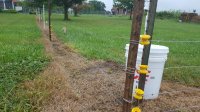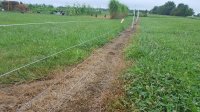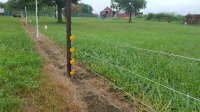CzyChikenMath
Songster
ohh important - did it work for fox and coyotes, do you know? if so I might be able to mange it during the day then add more wires when we move - as you say, minor expense upgrade... and the rotation areas will be even larger (now I split a half acre into 3 areas - but more space avail if needed)Robert is a sometimes poster on BYC. Perhaps he will weigh in?
I tried his 1....then 2 wire system. Those did not work for me as far as stopping predator traffic and deer...... but 4 wires do. The only additional expense of 4 wires over 1 or 2 is the expense of the extra wire. The same posts and fence charger works for 1 or more wires.
I think Robert has said the larger the area, the better it works.....at least as far as keeping the birds in. The larger the area, the less pressure there is for them to want to roam away from their home base. And perhaps those simple 1 and 2 wire fences would have eventually worked for me if I had been more patient? I did notice with the 1 and 2 wire systems, the birds got shocked when they stepped on the fence. You would see one launch straight up, then stand off in protest. Rather than an instant fix like electrified poultry netting is, maybe these 1 and 2 wire fences work best over time? You can speed that up with predators by baiting the wire so they are sure to find it......with their nose.






 (dwarf). Thank you Howard E!!!
(dwarf). Thank you Howard E!!!